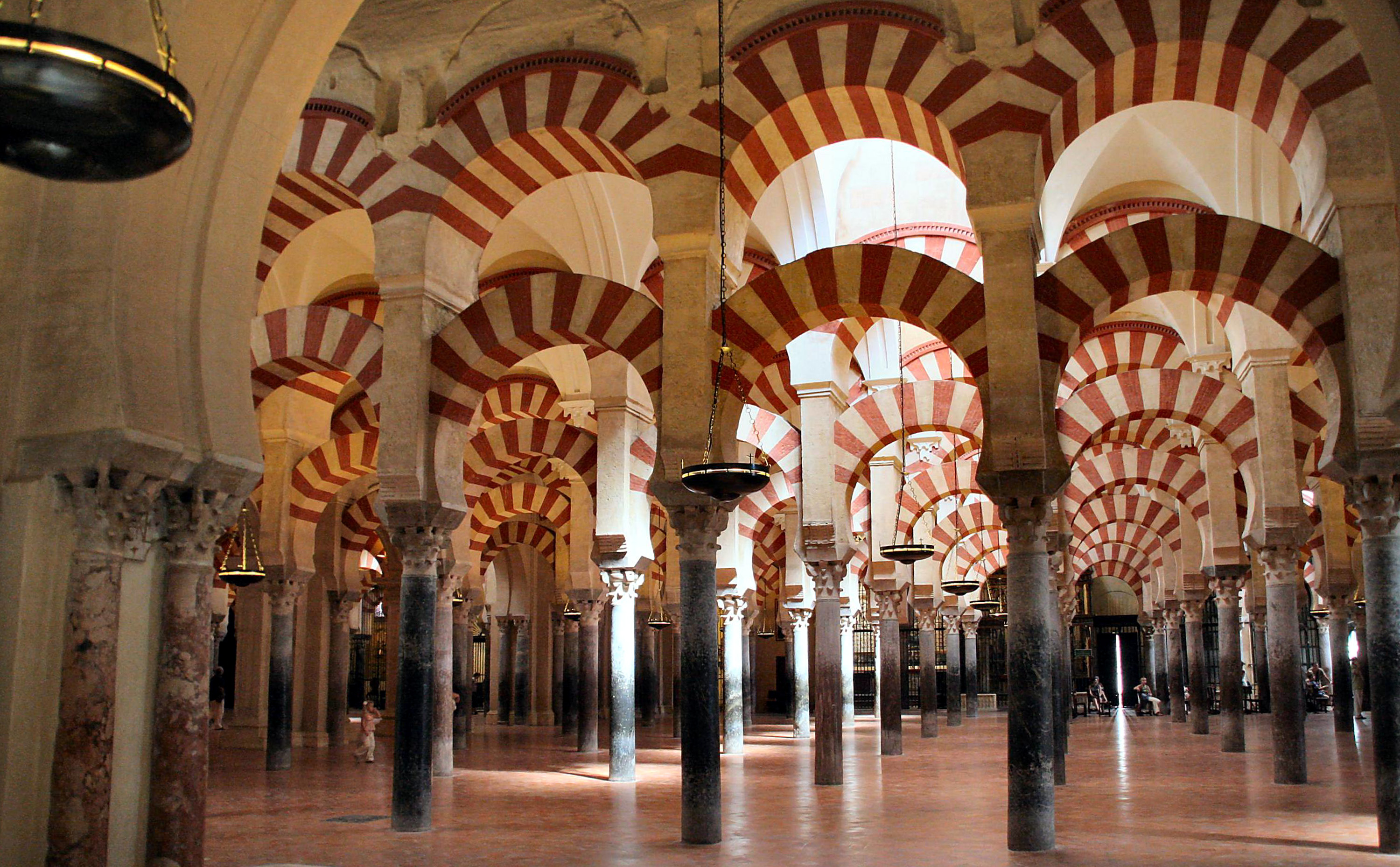That
| morning we packed up and hit the road for Córdoba, which is northwest of Granada. Córdoba, like Granada, had a less than attractive perimeter, but once in the city center it was clear where the historic sites were. We immediately pulled up to a dirt lot on the other side of the Puente Romano that spans the Río Guadalquivir. From our parking spot the Mezquita, the great mosque in the Jewish quarter, loomed in the distance. |
Entering Cordoba |
||

| The day was rainy, but reasonable since we planned on touring the mosque most of the time. Córdoba’s narrow, cobbled streets are renowned for fine silver jewelry and embossed leather, but first to the Mezquita. We entered the Puerta del Perdón (gate of absolution; Mudéjar-style gate built during Christian rule in 1377) and spilled into the Patio de Naranjas (courtyard with orange trees and rivulets of water where folks washed themselves before prayer). A 305-foot bell tower built on the site of the original minaret (Torre del Alminar) stands near the entrance, but was inaccessible when we attempted to climb it.
Once in the building, the true effect of the Mezquita hit me. More than 850 columns of granite, marble and jasper support the roof. Many of them were stolen from Roman and Visigothic buildings. Some of the columns were encased in plastic to protect engravings in unknown symbols/languages. One column also had a plastic yoke at the bottom and we could see that column continued beyond the existing floor – an indication that we were not treading on the original flooring. The arches seemed giraffe-like on close inspection, but from a distance were terribly impressive and overwhelming. There was also a highly decorated prayer niche that used to hold a gilt copy of the Koran (mihrab) and a caliph’s enclosure (maqsura). In the prayer niche we noticed the worn flagstones – apparently pilgrim’s used to circle it seven times on their knees. We also checked out the Capilla de Villaviciosa, which was hard to find because renovations were underway right next to it. Small, but architecturally intriguing because of the multi-lobed arches, it was the first Christian chapel built in the mosque by the Mudéjars (busy guys) in 1371. Even though it seems overshadowed by the other sights in the Mezquita, we were glad to see it. Probably the most ornate attraction in the mosque is the Christian cathedral right smack dab in the middle. Apparently, part of the mosque was destroyed to allow for the cathedral, and sure enough, it sticks out like a sore thumb. It has an Italianate dome and the choir has intricate, wood-carved stalls by Pedro Duque Cornejo. The choir is so big and the carving so detailed, it must have taken this guy a lifetime to complete the thing. All in all, we were very impressed by the mosque (Christopher even liked it better than the Alhambra) and as we exited we were treated to classical Spanish guitar played by the dirtiest, laziest looking bum we’d seen on the whole trip. He was hunkered in a dingy corner in tattered rags, but he knew how to play that damn guitar. We tried to figure out how to take a picture of him, but realized it would be impossible to capture the moment without him being cognizant of us. |
Stuff to See Everywhere |
||
| So we headed across the street into the neighborhood to check out the shops and the food situation. We stopped off in a leather store with lots of well made, embossed leather chests, journals, bookends, belts, bags, and trinkets. All the stuff I liked was too expensive, but the quality was good and the craftsmanship admirable.
During our walk we found some jewelry stores that I wasn’t terribly impressed with and lots of tourist traps with postcards, tacky shirts, plastic gee gaws and lace mantillas that looked like they were made out of plastic. When the rain really picked up, we settled in for lunch at a tucked-away, family-owned place that every other tourist managed to find too. The family next to us consisted of a pompous patriarch that managed to dominate most of the conversation with his weight-loss techniques, his discounted wife that was attempting to be heard on any level, and his two teenage daughters that were desperately trying to be profound and politically correct. And every other table in the room was occupied by a similarly disastrous microcosm of a different theme.
We attempted to visit the synagogue (Spain’s only other synagogues are in Toledo), but couldn’t find it. So we headed down to the Alcázar de los Reyes Cristianos (the palace-fortress of the Catholic Monarchs that was supposed to have neat looking water terraces and fountains in the gardens. Unfortunately, the rain was pretty thick at that point and we couldn’t even get across the dirt lot to the entrance because it had turned into a WWF female mud-wrestling pit. It was closed up tight anyways. Tired and wet, we decided to head back to the car and hit the road for Seville. Jake volunteered to run across the bridge and pick up the car. When he returned he informed us that the car had been broken into Spanish-style (jack-the-driver’s-side-door-and-crawl-through-the-back-seats-to-the-trunk) and that the laptop had been stolen. Everything was rifled through, but that seemed to be the only thing worth snagging.
So we spent the next hour trying to find the police station in the rain and then we spent three more hours after that trying to obtain a police report from the apathetic cops. Needless to say, the whole experience was stressful, undesirable, and discouraging – we were really enjoying ourselves up to that point. |

